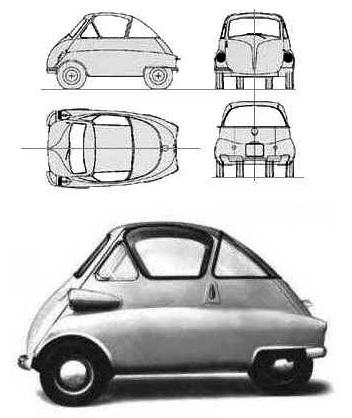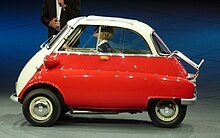Isetta - a car of a particularly small class , produced in the postwar period.
| BMW Isetta | |||||||||||||||||||||||
|---|---|---|---|---|---|---|---|---|---|---|---|---|---|---|---|---|---|---|---|---|---|---|---|
 | |||||||||||||||||||||||
| Total information | |||||||||||||||||||||||
| Manufacturer | BMW | ||||||||||||||||||||||
| Years of production | 1955 - 1962 | ||||||||||||||||||||||
| Assembly | |||||||||||||||||||||||
| Class | City car | ||||||||||||||||||||||
| Design | |||||||||||||||||||||||
| Body type | 1-dv. compartment (2-seater) | ||||||||||||||||||||||
| Layout | rear engine, rear wheel drive | ||||||||||||||||||||||
| Wheel formula | 4 × 2 | ||||||||||||||||||||||
| Engine | |||||||||||||||||||||||
| |||||||||||||||||||||||
| Specifications | |||||||||||||||||||||||
| Mass-dimensional | |||||||||||||||||||||||
| Length | 2285 mm | ||||||||||||||||||||||
| Width | 1380 mm | ||||||||||||||||||||||
| Height | 1340 mm | ||||||||||||||||||||||
| Wheelbase | 1,500 mm | ||||||||||||||||||||||
| Rear track | 520 mm | ||||||||||||||||||||||
| Front track | 1200 mm | ||||||||||||||||||||||
| Weight | 360 kg | ||||||||||||||||||||||
| On the market | |||||||||||||||||||||||
| Similar models | Heinkel kabine Messerschmitt KR200 SMZ S3-A | ||||||||||||||||||||||
| Segment | A segment | ||||||||||||||||||||||
| Modifications | |||||||||||||||||||||||
| |||||||||||||||||||||||


Isetta was one of the most successful microcars produced since World War II in the years when cheap transportation over short distances was most needed. . Despite the fact that the design was created in Italy, it was built in several countries, including Spain, Belgium, France, Brazil, Germany and the UK.
Due to the carriage layout, panoramic windows and rounded shapes, it became known as the "bubble car", this name was later borrowed by other similar vehicles. There were other nicknames. In Germany, there was das rollende Ei (rolling egg) or Sargwagen (meaning something like "coffin-car"; the name appeared due to the extremely low passive safety of the car), Halleluja-Auto ("car-hallelujah"; apparently, it’s also was in passive safety) and Adventsauto ("adventure car"). Knutschkugel ("bullet") was also popular . In France - Yogurt pot (jug with yogurt). In Brazil, it’s Bola de futebol de fenemê (soccer ball from FNM ), and in Chile it is still called “ Huevito ” (small egg).
Content
History
BMW, a major automobile manufacturer , was in complete decline after World War II . Of the five plants of this company, four were in the territory controlled by the NEA , and the plant in Munich was badly damaged as a result of the bombing. In addition, the Allied command, unlike interested in mass deliveries of vehicles for reparations of the Soviet administration in eastern Germany, banned BMW from producing cars. Only in 1951, BMW produced its first post-war car - the BMW 501 , but it turned out to be very expensive and was not successful in the market. The threat of bankruptcy loomed over BMW. By 1955, the situation became catastrophic and the company urgently had to find a solution.
At the same time, production of small cars under the name Isetta was established in Italy. This car was very different from all the others. In its form, it was more like a bubble than a car. Landing was carried out through a single door that opened in front, while the steering wheel moved with the door.
The car was designed for only two people and had a very small engine with a capacity of 9.5 liters. with. Most of all, this car was like a motorbike and did not have a reverse gear. In 1955, the Italian manufacturer Isetta decided to sell a license for its production in order to proceed with the production of more prestigious sports cars.
BMW decides to acquire the rights to manufacture this vehicle. BMW was able to increase the power of the Isetta engine to 13 liters. sec., which contributed to an increase in the speed of the machine. Isetta turned out to be a very suitable car for the city. In 1956, the Suez crisis occurred, which led to an acute shortage of gasoline . In this situation, the economical Isetta proved to be very popular. Until 1964, BMW produced 160,000 of these cars; by that time, other automobile companies began to produce cars a little more expensive than Isetta, but unlike it, they already looked like a full-fledged car. But despite this, the expected result was achieved - the production of Izeta allowed to improve the financial position of the concern.
Over eight years of production, three Isetta variants were made: double under the 250 and 300 indexes and four under the 600 index (also known as the BMW 600). Despite the straightforwardness, the machine was very reliable in technical terms and its only drawback was poor corrosion resistance .
Now this car makes many people smile, but it was thanks to him that BMW was able to achieve great success and was saved from bankruptcy .
Iso Isetta (Italy)
The original origin is from the Italian company Iso SpA. In the early 1950s, the company was manufacturing refrigerators, scooters and small three-wheeled trucks. The owner of Iso, Rivolta Renzo, decided to build a small car for mass consumption. In 1952, engineers Ermenegildo Preti and Pierluigi Ruggie developed a small car that used a scooter engine and named it Isetta - an Italian diminutive of the word Iso. As they say, stylists designed the Isetta car by combining two scooters, putting them close to each other, adding a refrigerator and forming a drop-like result.
VELAM Isetta (France)
VELAM acquired a license from Iso in 1954 for the production of cars based on Isetta. Since Iso sold bodybuilding equipment to BMW, VELAM developed its own bodies, but used the original Iso engines. Instead of the chassis of the Italian and German versions, in the south they used a frame bolted to the chassis at the rear to fasten the rear tires, engine and transmission. The front suspension was bolted to the front of the body. The front door was opened with a button instead of a handle, and the speedometer was mounted in the center of the steering wheel.
VELAM began production of cars in 1955 at the old Talbot factory and the car was shown in 1955 at the Paris Automobile Show . Five versions of the car were presented: the standard Isetta, the convertible version, the luxury version, the pseudo-sports version and the sports car. Due to competition from Renault Dauphine , production ceased in 1958.
Romi-Isetta (Brazil)
In 1955, they bought an Isetta license for a machine tool plant with headquarters in the city of Santa Barbara, in the state of Sao Paulo. Isetta was chosen because it was an ideal tool for use in cities, due to its size and fuel economy. Released on September 5, 1956, it was the first car made in Brazil.
3000 pieces of Romi-Isetta were made between 1956 and 1961. They maintained the Iso design and used Iso engines until 1958; in 1959 they switched to BMW 300 engines.
BMW Isetta (UK)
Isetta is ideal for UK urban and rural roads, given ample space for two and their luggage. The first M1 motorway was not opened until 1959, and most ordinary cars barely reached 60 mph (97 km / h). In 1957, the Isetta 300 began production in the UK. In 1962, the Isetta plant stopped the production of microcars, but produced engines for the Isetta until 1964.
Gallery
Isetta 300 - control panel
Isetta 300 - rear view
Isetta 600
Two-tone BMW Isetta 250
Intake grille
See also
- Motorcycle stroller
- Messerschmitt KR200
- Dinarg d-200